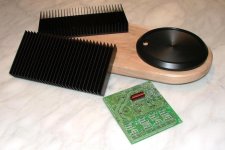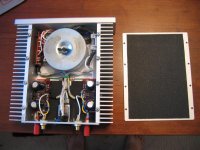If you mean the blue thing, it's only for the photo, to show what is going to be used for the lug connectors. It's a lug contact without a cable.rabstg said:What is the “extra” male quick connects on the board for? 2 for AC input, but I counted 3-4 more on the board.
To peranders : As I see, quite perfect designed PCB and precise work. If I may recomend to you, try to use for soldering Multicore Crystal 502 tin, which is the best tin for hand soldering what I know. But it must be from Multicore, not from other firms ( Crystal 502 is name of industry standard, is made by other firms too )  , 'cos from other firms is not so good.
, 'cos from other firms is not so good.
Hi Peranders-
The blue female quick connect is plugged onto a quarter inch male quick connect that is soldered onto the board.
The part that is soldered onto the board is the part I'm curious about. I see 2 x pwr input, 2 x spkr output but then a few other "extras" on the board.
Thanks again,
Troy
The blue female quick connect is plugged onto a quarter inch male quick connect that is soldered onto the board.
The part that is soldered onto the board is the part I'm curious about. I see 2 x pwr input, 2 x spkr output but then a few other "extras" on the board.
Thanks again,
Troy
I'm happy to see that the list is getting longer and longer and I really hope that as many people as possible will finish their projects because this design will be good. I'm quite convinced of it. No signs so far has pointed in other directions than this.
I'm also puzzled why mostly swedes find this project interesting?
At the moment two beta testers are assigned (Walter, Germany (EDIT: sorry Belgium) and Anders, Norway) but two more are welcome.
I'm also puzzled why mostly swedes find this project interesting?

At the moment two beta testers are assigned (Walter, Germany (EDIT: sorry Belgium) and Anders, Norway) but two more are welcome.
Opamp missing
Hi P-A!
Nice to hear that Your amp is starting to make sound.
I have not received any AD8620 yet from Analog Devices. Where is it possible to buy it?
Could I use an OPA2143 instead? (At least for a start)
I can't find the insulated (TF) version of the 3886 at Elfa or Farnell
either. Where to buy these?
BR Anders.
Hi P-A!
Nice to hear that Your amp is starting to make sound.
I have not received any AD8620 yet from Analog Devices. Where is it possible to buy it?
Could I use an OPA2143 instead? (At least for a start)
I can't find the insulated (TF) version of the 3886 at Elfa or Farnell
either. Where to buy these?
BR Anders.
Hey Peranders-
I'm sure others like myself are intrigued and interested but just don't feel comfortable soldering SM devices.
I've been soldering for 20 yrs and still feel nowhere near comfortable enough for the SMD components.
The project looks great, and if you make the board available with the SMD components pre-installed I'd be more than happy to buy a set to try.
But they sure look good.
Thanks,
Troy
I'm sure others like myself are intrigued and interested but just don't feel comfortable soldering SM devices.
I've been soldering for 20 yrs and still feel nowhere near comfortable enough for the SMD components.
The project looks great, and if you make the board available with the SMD components pre-installed I'd be more than happy to buy a set to try.
But they sure look good.

Thanks,
Troy
If you only can borrow a second soldering iron, it's easier than you think to solder all 0805 parts.
You can always check out my holemounted Gainclone or check out Rod Elliott's or www.chipamp.com or digi01's or Jens Rasmussen's (or was it some other dane?) or....maybe the new AKSA-clone(*) ....you have many options.
....you have many options.
*) No, Mr. Dean is not going to release any new LM3875 based amp.....
You can always check out my holemounted Gainclone or check out Rod Elliott's or www.chipamp.com or digi01's or Jens Rasmussen's (or was it some other dane?) or....maybe the new AKSA-clone(*)
*) No, Mr. Dean is not going to release any new LM3875 based amp.....
Soldering SMDs isn't hard at all, really. I can solder 0603 resistors with a crappy Weller solder iron (I'm not talking about the temperature regulated ones, I'm talking about on of the most basic models you can buy). Try it! (And check out my tutorial on it: http://members.lycos.nl/anthonyvh/index.php?page=smd.)rabstg said:I've been soldering for 20 yrs and still feel nowhere near comfortable enough for the SMD components.
How much easier is easier? Because I just bought a Metcal MX-500 soldering station on eBay and I also bought a new soldering iron for it (it wasn't included). Of course I also needed soldering tips, but with the soldering tips and iron & a stand was also included (which I had already bought). So I plan to sell one of the irons and one the stands for ~€100 again (since I find ~320€ a bit much for a soldering station and accessories, even if it's supposed to be one of the best ones money can get), but if you think it is really worth having 2 soldering irons to do SMD, I might keep it.peranders said:If you only can borrow a second soldering iron, it's easier than you think to solder all 0805 parts.
Hi Peranders-
I have an ex-coworker and friend who used to work in radio remanufacturing. He is quite good at soldering SMD's and he agreed to assist me in learning.
So I will be designing a new project similar in execution to your and Epos' style. In other words an "all inclusive" design and not minimalistic design.
As for building a hole through amp, I have. I was intrigued by and want to listen to an SMD design.
Thanks, Troy
My GC:
I have an ex-coworker and friend who used to work in radio remanufacturing. He is quite good at soldering SMD's and he agreed to assist me in learning.
So I will be designing a new project similar in execution to your and Epos' style. In other words an "all inclusive" design and not minimalistic design.
As for building a hole through amp, I have. I was intrigued by and want to listen to an SMD design.
Thanks, Troy
My GC:
Attachments
rabstg said:As for building a hole through amp, I have. I was intrigued by and want to listen to an SMD design.
Please do.
 Go for it!
Go for it! 
Maybe you also will find it exciting to work with small things.
Nice work, your PD/BGT gainclone

Since people ask me about a couple of things the follow text might be informative:
(quoted from my home page)
Power supply
As you may have noticed I have not chosen to have each rail voltage on each side. I have chosen to have all the power at the left side of the pcb and have sensitive signals on the right side. The pcb gets a bit "unbalanced" to the looks but electrically it feels better. As you also can see I have made an option for "plain" electrolytic caps and for heavy duty types with snap-in pins.
Rectifier bridges
I really recommend you to have two separate windings connected to two separate rectifier bridges. You can either have really big TO247 diodes which costs a lot and may be overkill technically but you can also have TO220 types which are much cheaper and more "normal" and definitely sufficient. Both diode types can be attached to a heatsink. The gap between the diode rows is for this purpose but please beware of that the diodes need insulation.
You can also use only one rectifier bridge. Then you will not use X3 and X7 but X5 and X6 will be used instead.
(quoted from my home page)
Power supply
As you may have noticed I have not chosen to have each rail voltage on each side. I have chosen to have all the power at the left side of the pcb and have sensitive signals on the right side. The pcb gets a bit "unbalanced" to the looks but electrically it feels better. As you also can see I have made an option for "plain" electrolytic caps and for heavy duty types with snap-in pins.
Rectifier bridges
I really recommend you to have two separate windings connected to two separate rectifier bridges. You can either have really big TO247 diodes which costs a lot and may be overkill technically but you can also have TO220 types which are much cheaper and more "normal" and definitely sufficient. Both diode types can be attached to a heatsink. The gap between the diode rows is for this purpose but please beware of that the diodes need insulation.
You can also use only one rectifier bridge. Then you will not use X3 and X7 but X5 and X6 will be used instead.
Today I have listened to a Gainclone for the first time ever.
With MUR3020 diodes, 2 x 4700 uF heavy duty caps ELNA LPJ3, 200 VA, 2 x 24 VAC, buffer AD8620, otherwise according to the original design, this amp really sings. Reptile fast deep bass, snappy, firm, dry, warmth in the mids, razorsharp treble, very good "S"-sounds, simply a crystal clear sound.
Need I say that the amp has a silent turn-on and an equally silent turn-off?
Offset voltage 12 uV.
I can't really see why some wrinkle their noses for the monolithic amps? As a low poer amp I think this is a very easy way to get good sound.
I can imagine that SonnyA had more fun when he designed his current feedback amp but I think this is pretty fun to.
Those who succeed to build this amp (which you will if you aren't in too much hurry and are thourough) will be very pleased. I'm quite convinced of that.
I'm happy this Friday!


With MUR3020 diodes, 2 x 4700 uF heavy duty caps ELNA LPJ3, 200 VA, 2 x 24 VAC, buffer AD8620, otherwise according to the original design, this amp really sings. Reptile fast deep bass, snappy, firm, dry, warmth in the mids, razorsharp treble, very good "S"-sounds, simply a crystal clear sound.
Need I say that the amp has a silent turn-on and an equally silent turn-off?
Offset voltage 12 uV.

I can't really see why some wrinkle their noses for the monolithic amps? As a low poer amp I think this is a very easy way to get good sound.
I can imagine that SonnyA had more fun when he designed his current feedback amp but I think this is pretty fun to.
Those who succeed to build this amp (which you will if you aren't in too much hurry and are thourough) will be very pleased. I'm quite convinced of that.
I'm happy this Friday!



- Status
- This old topic is closed. If you want to reopen this topic, contact a moderator using the "Report Post" button.
- Home
- Group Buys
- Industrial SMD Gainclone - group buy

